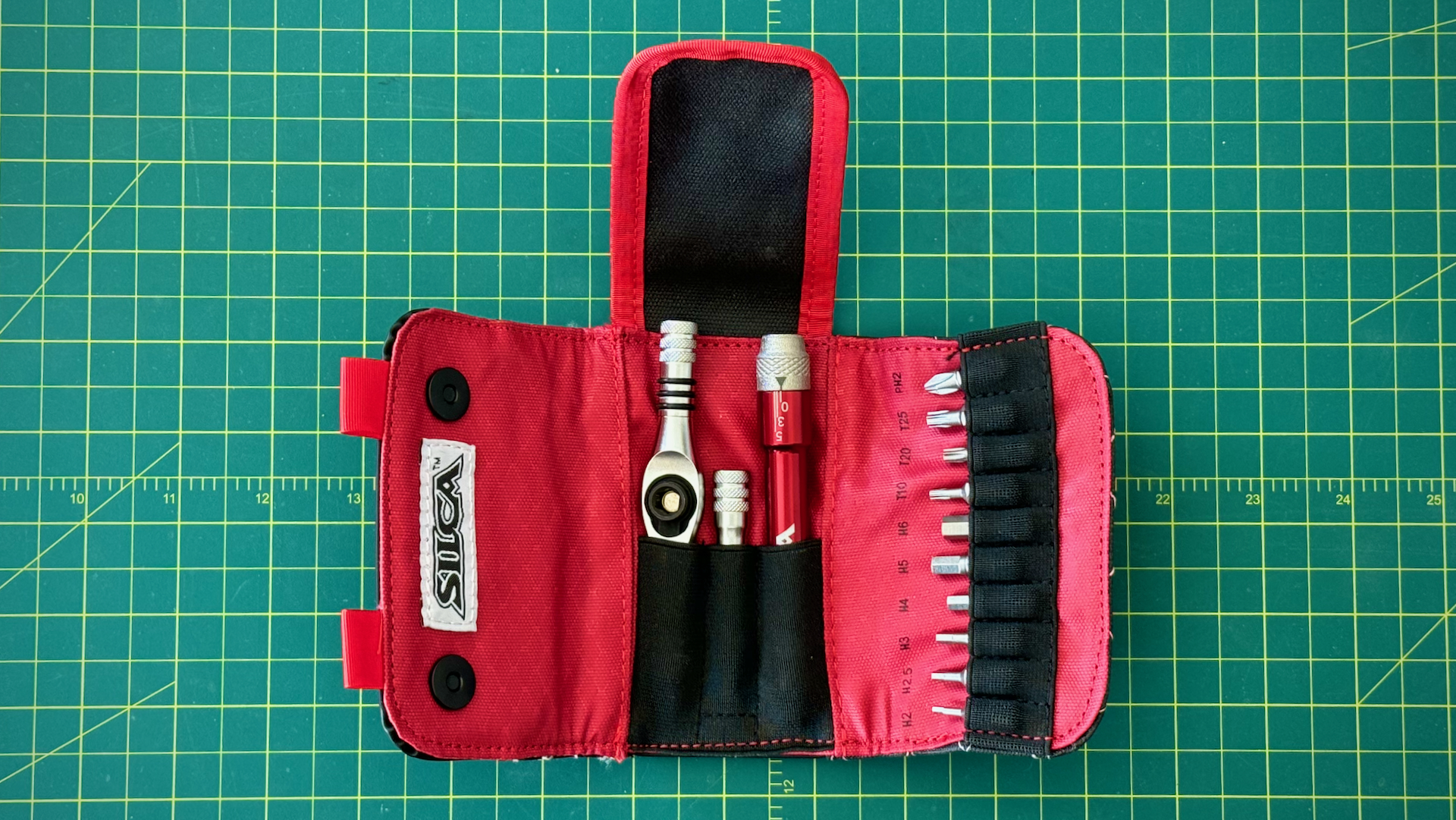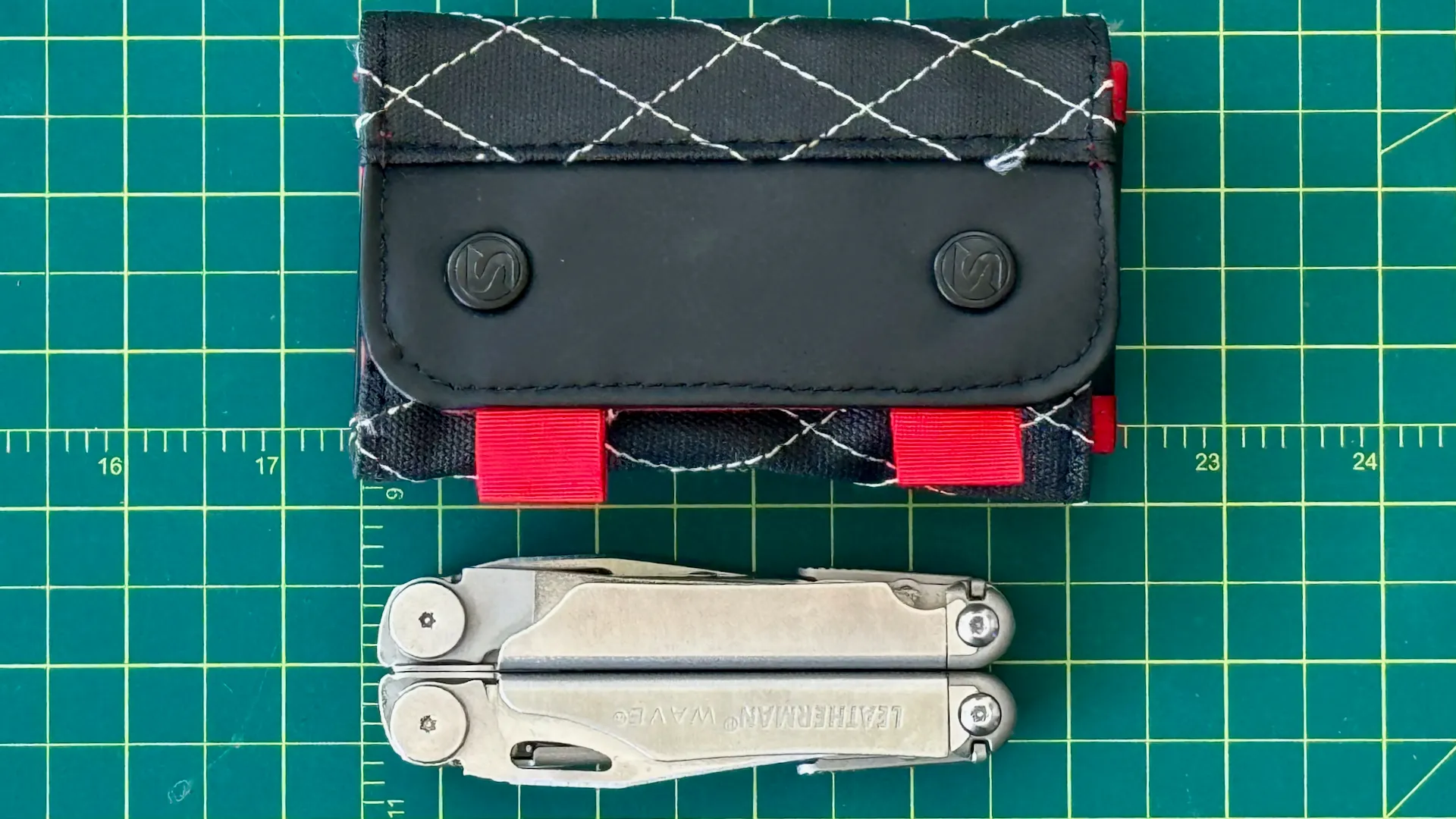

We may earn revenue from the products available on this page and participate in affiliate programs. Learn more ›
A few months ago, I started down the rabbit hole of exploring everyday carry (EDC) objects after having a problem while on a bike ride. I carry a pretty standard bike multitool and I found it basically useless. I’ve had countless Swiss Army knife-style EDC tools for nearly three decades. I got my first Leatherman as a gift when I was a teenager. They seem to have continued multiplying since then. When I started researching EDC, I discovered a whole world of people who are also frustrated by multitools and have started carrying micro tool kits. We’re moving way past what fits in your jean’s pocket, so most of these EDCers are carrying bags.
This Silca T-Ratchet is one of the first mini tools I’ve bought myself. It’s also probably the first I bought with a specific job in mind. And yes, I did buy this on my own. As far as I know, Silca has never even heard of me, there’s no connection. Although The Drive will receive a commission if you buy one using our links.

I’m guessing most of you have never heard the name Silca. But, if you’re a cyclist, the mere mention gives your heart and wallet a flittering lightness few others can. In the car world, we have Momo, BBS, and maybe Recaro, which have the same iconic status. Silca was founded in Milan, Italy by Felice Sacchi in 1917. The company started by making air pumps and was the first to sell a high-pressure floor pump with a pressure gauge. The company later made the first high-pressure compact frame pump, which changed roadside flat repair.
Silca pumps are still coveted today, many of them produced decades ago are still in service. Yes, you can still buy replacement parts for a pump from the 60s. The Sacchi family owned the company until 2013, when it was sold to Josh Poertner, an American and tech-nerd of the highest order. No longer in Italy, Josh moved the company to Indianapolis. Indiana where it swims in the same pool of innovation as the motorsports industry. If you, like me, can watch hours of in-the-weeds technical content, I urge you to check out Silca’s YouTube channel.

What are the specs of the Silca T-Ratchet kit?
List price for this is $125 although you can sometimes find it on sale. We’ll talk value later. I bought this primarily to carry on my bike. Although it does fit nicely in the sling bag I use to carry my laptop. While on the bike, it fits in a handlebar bag and it isn’t much bigger than an energy bar. The actual measurements are 4.7 x 2.8 x 1.1 inches and it weighs 8.0 ounces(226 grams in Cyclish or a little less than 4 average glazed donuts). The wallet is made from waxed canvas and the materials are befitting a quality outdoor product. All the pieces of the kit are secured in the wallet under elastic webbing and there’s an extra compartment for tube patches, quick links, or even emergency cash.

The Silca T-Ratchet kit includes: The ratchet, an extension, and the torque beam. For bits: 2, 2.5, 3, 4, 5, 6mm hexes, t10, t20, t25 Torx, and a 2mm Phillips. This is pretty comprehensive, I really only need a tire kit besides this. If I’m carrying this for normal EDC, I’ll swap out the Torx for a flathead and a quarter-inch square drive for sockets. I should point out, the bits are interchangeable with the seemingly endless supply in my toolbox, tool cabinet, junk drawer in the kitchen, and somehow mixed into the coin jar.
How does the Ti-Torque stick work and do I need it?
Although I can’t find a store that has them in stock, you can buy the kit without the torque stick, and I’d imagine that’s what most non-cyclists will want. According to industry data, 70% of high-end bike frame damage is caused by over-tightened fasteners. I would imagine an even higher percentage of aluminum bike components fall victim to the same thing. My gravel bike is carbon fiber. All the other bikes in my garage are aluminum. Fasteners on my bikes are almost entirely steel — I can’t afford, nor do I need, aftermarket titanium fasteners. If I hamfist a fastener, my 3-cent fastener is fine, my 4-figure frame will lose.

I own four torque wrenches and a few torque adapters. The minimum torque spec I can do with lowest rated torque wrench is 10 lb-ft, which is 13.6 Newton-meters. Most of the bicycle fasteners you would touch on a ride are between 3 – 6 Newton-meters. I’ll be honest, my first thought is, why do I need a tool to do these really low torques? Then, I think, if the torque is that low, the odds of my reefing on that thing until I hear a pop is very high. But, how does it work? There is a calibrated beam in the center of tube. As you torque it, the tube moves in relation to end of the tube with the tool holder. You can see the arrow move on the scale. Now, like other beam-style torque devices, there is no click, beep, or chirp. You have to watch the gauge.
Can I really use the Silca T-Ratchet for normal EDC?
I have been asked, “What can you actually do with that thing?” You aren’t going to change an alternator on the side of the road with this. But, you aren’t going to do that with a Leatherman, are you? This slots in between a real set of tools and a multitool in terms of usefulness. At home I have plenty of tools, but if I’m at a friends house, someone whose tool kit consists of whatever came with their IKEA furniture, I can easily use this to take apart a computer, or an appliance. And yes, I can build the sh** out of an entire apartment full of Swedish flat-pack furniture with the Silca T-Ratchet.

I included a photo with the T-Ratchet next to a bike multitool from Bontrager and one that’s some SkyMall nonsense. I also have a photo next to a typical fold-out multitool. Although I love the idea of having pliers with me at all times, the number of times I’ve used them in the past decade is exactly zero. No seriously, it’s been over 10 years since I’ve used the pliers on a multitool. *My memory is anything but bulletproof, but if I’ve used them more than twice, I’m pretty sure I would remember at least one instance.
The biggest advantage of the Silca kit is the ratcheting. There isn’t much in the tool world as frustrating as trying to use a driver with a fastener end that isn’t concentric to the handle. OK, one thing that is neck-in-neck in frustration is when the handle of the tool is so bulky you can only get an eight of a turn and then have to remove the tool and reset. Now, factor in that the bit falls out of the tool every time, you’re on the side of the road trying to do this while trying to hold the part in place, and the bike, and you realize why I spent the money on the Silca tool.

Anyway, in the few weeks I’ve had this tool, I have found it far more useful than any other multitool I’ve owned. It can work as a T-handle, a normal ratchet handle, it comes with an extension, and everything is held together with surprisingly strong rare earth magnets, so it snaps together in whatever configuration you need instantaneously.
Silca T-Ratchet and Ti-Torque EDC Tool: The Verdict



So I’ve already stated that for cyclists, especially of a certain age, anything Silca is an aspirational purchase. It doesn’t make sense, and it doesn’t have to. Does a Rolex tell time any better than a Timex? Does a Bentley get you to work any differently than a Toyota? Well, no. But for some of us, yes. It’s experiential. It’s emotional. And it’s dumb. I think that sums up being an enthusiast pretty well.
I do have complaints. This is the one that hurts the most. When you are set to loosen, the ratchet skips one pawl at the start of every rotation. It doesn’t do it tightening. I thought I might have a defective unit but I’ve read dozens of comments from other owners and it’s unsettlingly common. Even with my explanation in the paragraph above, I’m still going to complain about the price.
I know I’m mostly speaking to enthusiasts here at The Drive. So I know you all appreciate spending too much money on unnecessary things. But as a professional, I’m still pointing out that even with the beautiful machining, the great materials, and the care went into making this tool kit, you can get the same utility for a lot less money. Here’s a PSA: this type of ratchet is referred to as a “1/4-inch hex drive bit ratchet” or sometimes an “Electrician’s mini ratchet.” You can find Wera and Wiha sets, the German tool fan lust-worthy equivalent of Silca, for a fraction of the price. But, as far as I can tell, none of the tool brands offer a tiny torque stick.
I’m having a hard time recommending the Silca T-Ratchet and Ti-Torque for a normal use case. It’s obviously useful for cyclists because of the torque stick. Some EDC fans will love it for the quality of the machining and the almost jewelry-like qualities. But, when I look at this from purely a tool-user perspective, it’s hard to find the value in the limited utility. Again, I find this much more useful than the average multitool if you’re using it for fasteners. If I was taking apart an electric can opener, I could do it twice as fast with a tenth of the frustration with this compared to my Leatherman. But, how often am I MacGyvering an appliance with no tools?
This is the lowest score I’ve given to any product since we started using this format. It doesn’t reflect how much I personally like the Silca T-Ratchet and I don’t regret buying it. I hope that most people that have aspirational objects they’ve always wanted won’t be dissuaded by this, you never wanted them for the practical utility anyway.
| Silca T-Ratchet and Ti-Torque | |
|---|---|
| Value | 4/10 |
| Quality | 7/10 |
| Durability | 7/10 |
| Ease Of Use | 8/10 |
| Overall | 6.5/10 |